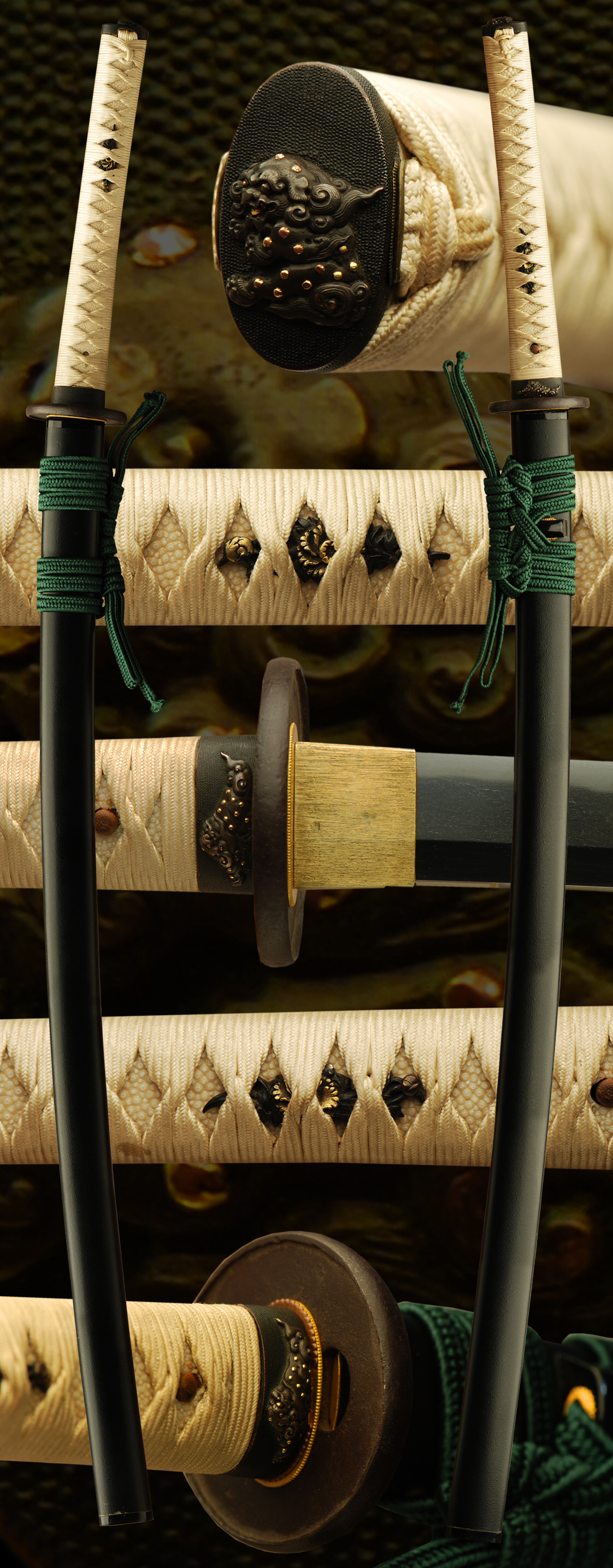A SWORD SIGNED AND PAPERED TO: ” ECHIZEN JU HARIMA DAIJO FUJIWARA SHIGETAKA “
At the beginning of the Shinto period Echizen province (now Fukui pref.), also known as the Azuchi-Momoyama period in the 1570s, Native sword smiths from Seki, Mino provence such as KANETANE 兼種, KANENORI 兼則 had moved and MASANORI 正則 were invited from the capital of Yamashiro to Fukui, Echizen provence.
The AOI crest was bestowed on YASUTSUGU 康継 from the Lord Tokugawa and 16 petals KIKU crests were bestowed from the Imperial Court on KUNIKIYO 国淸 of Kunihiro school. They strived to attain the skill for performance, strength and beauty of the martial spirit with the increasing demand from the Samurai.
The smith SHIGETAKA 重高 with the official title of Harima-daijo 播磨大掾, had come from Iida, Shinshu provence then moved to Seki, Mino to become a disciple of KANENORI 兼則.
SHIGETAKA 重高 had moved to Ichijōdani, Echizen to accept an invitation to work for the Asakura clan along with his master KANENORI 兼則.
From the later Muromachi period onwards, Mino province saw a steady outflow of swordsmiths, a trend that saw its peak in the Momoyama and early Edo period. Reason was for the most part the then significant demand for swords and thus local daimyô began to recruit famous masters to work for them on their lands. Mino bldes, or Seki blades in particular, were regarded as being durable and sharp and so a downright wave of migration of Mino/Seki swordsmiths can be seen, especially in the neighboring provinces of Owari and Echizen. As for Echizen, the province also gave a new home to many formerly Ômi-based Shimosaka smiths, thus we use classifications like “Echizen-Seki” (越前関) and “Echizen-Shimosaka” (越前下坂) to refer to these two different currents. The “trend-setters” of the Echizen-Seki group were first and foremost the Tenbun-era (天文, 1532-1555) Kanenori (兼法) and the two Keichô-era (慶長, 1596-1615) masters Kanenori (兼則) and Kanetsune (兼常).
This sword was most likely made by 1st or 2nd generation SHIGETAKA 重高 who acquired the beautiful technique of the Shinto-era that emerged from the Koto period.
During the early Edo period, it was the main focus of forging the tamahagane from theTATARA furnace that had many different ratio’s of carbon content resulting in an Itame structure with superior construction and better cutting performance. These katana lived up to it’s reputation as Wazamono or Supreme Sharp Cutting Performance.
This was designed to present to the samurai, a sword full of the Samurai martial spirit. It’s Nagasa at katana length is both beautiful and impressive.
Having a wide and thick Kasane much hiraniku can be found , this is the typical shape of the Kan’ei (1624-) period.
This blade comese with a wonderful koshira. The saya is a black lacquer finish with green sageo. The ito is white with a floral themed menuki. The fuchi Kashira are of very high quality depicting ShiShi:
Shishi (or Jishi) is translated as “lion” but it can also refer to a deer or dog with magical properties and the power to repel evil spirits. A pair of shishi traditionally stand guard outside the gates of Japanese Shinto shrines and Buddhist temples, although temples are more often guarded by two Nio protectors. The Shishi (like the Nio) are traditionally depicted in pairs, one with mouth open and one with mouth shut. The opened/closed mouth relates to Ah (open mouth) and Un (closed mouth). “Ah” is the first sound in the Japanese alphabet, while “N” (pronounced “un”) is the last. These two sounds symbolize beginning and end, birth and death, and all possible outcomes (from alpha to omega) in the cosmic dance of existence. The first letter in Sanskrit is “Ah” as well, but the last is “Ha.” Nonetheless, the first and last sounds produced by the mouth are “Ah” and “M.” The Sanskrit “m” and the Japanese “n” sound exactly the same when hummed with mouth closed. The spiritual Sanskrit terms AHAM and AUM thus encapsulate the first letter-sound (mouth open) and the final sound (mouth closed). Others say the open mouth is to scare off demons, and the closed mouth to shelter and keep in the good spirits. The circular object often shown beneath their feet is the Tama 玉, or sacred Buddhist jewel, a symbol of Buddhist wisdom that brings light to darkness and holds the power to grant wishes.
The Samegawa has a classic clean patina and the tsuba is a very nice ( Maru-gata ) rounded style with plain background and Mimi. (rim)
- Mei: Echizen-jū Harima no Daijō Fujiwara Shigetaka
- Date: Edo (1600’s-1700’s)
- Nagasa: 29.88 inches
- Sori: 15.0 mm
- Width at the ha-machi: 31.5 mm
- Width at the yokote: 21.7 mm
- Thickness at the mune-machi: 7.2 mm
- Construction: Shinogi zukuri
- Mune: Iori
- Nakago: Ubu
- Kitae: Itame/mokume
- Hamon: Midare Gunome
- Boshi: Maru
- Condition: Good polish
(shipping and insurance included)
Email us if your interested in this item and remember to include the order number for this item: fss-761.
Click to Enlarge Image
Click to Enlarge Image
kantei-sho (鑑定書) No 300865 katana, mei: Echizen-jū Harima no Daijō Fujiwara Shigetaka (越前住播磨大掾藤原重高)
nagasa 2 shaku 5 sun 0.5 bu Migi wa tô-kyôkai ni oite shinsa no kekka, hozon-tôken to kantei-shi kore o shô-suru.
(右は當協會に於て審査の結果保存刀剣と鑑定しこれを証する)
Heisei nijūyonen rokugatsu nijūichinichi (平成二十四年六月二十一日)
kôeki-zaidan-hôjin (公益財團法人): Nihon Bijutsu Tôken Hozon Kyôkai (日本美術刀劍保存協會)
Appraisal
katana, signed: Echizen-jū Harima no Daijō Fujiwara Shigetaka
nagasa ~ 75.9 cm According to the result of the shinsa committee of our society we judged this work as authentic and designate
it as hozon-tôken. June 21, 2012 [Foundation] NBTHK
For Sale

























